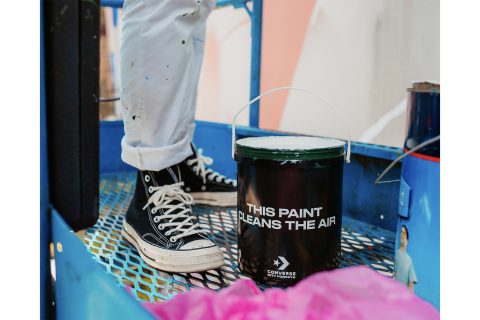
Gumbbaynggirr artist Aretha Brown wears a grey jumper and navy shorts, with bits of paint smeared across every inch of fabric. She looks like a human palette, and perhaps slightly dishevelled, yet who wouldn’t after hours of scaling and painting a wall.
We’re at the Converse Factory Outlet on Collingwood’s Smith Street where the shop’s half-painted south-facing wall is becoming the brands latest addition to its ‘Converse City Forests’ series, an initiative employing artists from around the globe to create murals using Graphenstone air purifying paint. A product that uses sunlight to reduce noxious air pollutants, leaving harmless free-radicals that can be washed from the film of the paint each rainfall.
It’s impressive how many people are here. They bustle about like worker bees, either painting, overseeing, or working the lift where a couple of artists stand atop. “This is crazy, so many people around just for your artwork!” Aretha smiles, “Yeah, it’s pretty fun.” Brown is the figurehead of this particular operation, and it’s her bold, contrasting painting style that is beginning to fill the once plain-grey wall. Every now and then she stands a few metres back, studying the black strokes of paint as the others watch, to then move forward again to correct a line that – in her eyes- sits slightly out of place.
It’s with this deep ceded confidence that I imagine has gotten her to this present point. At only 20 years old Aretha has achieved on a level well above most. From her role as the youngest and only woman Prime Minister of the National Indigenous Youth Parliament in 2017 to her speeches to crowds of thousands at Invasion Day marches in 2016/17, to her art that hung on the walls of the NGV, to her constant discourse on Indigenous rights, she’s as multifaceted as she is talented.
Now, aside Converse, sustainability sits at the heart of this latest mural. And with Brown the obvious choice for the Melbourne leg of the series, a shirt designed by the artist and in support of NIYEC (National Indigenous Youth Education Coalition), an organization that aims to integrate indigenous history into high schools, will also be released via the Converse website. “The Mural draws on multiple themes. It is a celebration of Aboriginal matriarchs and signifies the integral role of elders as a pillar for community, whilst also acknowledging the role of young mob and how Indigenous culture exists within modern life”
Lucky enough to catch up with Brown on her second day of painting we talked with her about her collaboration with Converse, her focus on sustainability and, briefly, her work to date.
So how did you first get contacted by Converse?
I’d worked with Converse before with a different campaign. I did one back in 2017 and it was around the marriage equality “debate”, for lack of a better word. It was that year where they voted ‘YES’ and they released a pride collection, and I did some work with them and so when Grace Dlabik [Brown’s Manager] flagged this I was like ‘Ah, I love Converse, they’re really cool, I like their brand and what they represent, so I was like, ‘Let’s do it!’
What was the brief for the wall today in terms of what they wanted you to paint?
They kind of gave me free rein which was pretty cool. They let me do whatever, which is really nice of them. Some people can be a bit pedantic about what they want and how they want me to do things, but it can almost be more rewarding when I get artistic freedom to do what I want.
Yeah, definitely. So, what was your inspiration for the wall?
Collingwood. Smith Street is a really historically significant area for Aboriginal people in Melbourne, you know, we’ve got the Victorian Aboriginal Health Care Center around the corner, we’ve got the Victorian Aboriginal Childcare Agency, this is kind of just a big area, you know back in the day. I think translating that kind of urban Indigenous experience into a mural is what I’m trying to do.
And I know that you’re using sustainable paint. Why do you think sustainability is important, and why did it attract you to this project?
Well at the end of the day, environmentalism is indigenous rights. I find them to go hand in hand. They’re pretty much the same thing in my eyes considering that so much of my community’s philosophy is looking after the environment, making sure that it’s mob in charge of teaching others environmental knowledge and looking after land, and being the utmost sustainable that you can be. I think that’s what I stand for and that’s why I support it.
And you’re also designing a t-shirt with converse, with proceeds going to the National Indigenous Youth Education Coalition (NIYEC). How are you involved with them and why is their work so important to you?
Sure, so NIYEC is a group I’ve worked with for a bit now. We put in a panel, not last year but the year before, we’ll forget about last year as a year (laughs). It was a student panel with a bunch of young indigenous students, speaking about their experiences in high school. Now I work with them when I can and give them a shout out because their message is getting Indigenous history taught in high schools, which is what I very much believe as well, so I thought that was the perfect alignment.
Focusing on you and your previous work, you’re someone that seems to fill a lot of spaces; you’re an artist, an activist — you probably get this question a lot — but what do you see yourself as or how do you see yourself in regards to what you do?
It’s a big question, isn’t it? I don’t know, I’ve always had a big issue with the term “activist”. It’s not something I really call myself. I almost find it a bit uncomfortable, just because I don’t quite resonate with it. I think being an artist feels more comfortable for me. Because at the end of the day I’m just speaking to people about my experiences in high school and my own experiences as a young aboriginal person, and I’m just trying to do that any which way how. I’ve done panels, I’ve done talks, I do murals and it’s just me trying to work out how I can explain the politics that I have in as many ways as possible.
Being born indigenous you have an inherently political identity already, is it ever hard to be pigeonholed as an “indigenous” activist?
Yeah, I think so. That’s why I’ve always had a bit of an issue with that term. I just want to make great art and I just want to get my community, which is a lot of different communities — everyone’s a very complex person — I’ve got my queer community, being female, and fem-identifying, having women around me is also my community, and indigenous, there’s so many things and they all come together. Making amazing art that says something is kind of all I wanna do and if you want to call that activism then I don’t know.
I watched a couple of interviews where you said you were trying to bridge the gap between two groups of people who didn’t really know each other, what kinds of difficulties have you faced in that process?That’s a big question. I don’t think I’m trying to bridge, just by the virtue of being a mixed-race person you are a literal bridge for communities (laughs). You are an actual physical representation of that and regardless of if you’re indigenous or if you’re mixed race, then you are a literal bridge between two communities. Whether you’re half Viet, half Aussie, or half Indigenous, you’re kind of getting to understand both worlds through your own unique eyes, and that’s why I think mixed-race mob have a very interesting status in terms of how you can almost translate cultural differences in a different way, but I don’t know what problems I’ve had. I suppose there’s stuff every day just by virtue of being an indigenous person but you just have to kind of push through it.
I actually watched your documentary ‘How to be cool in Melbourne’, it’s really funny, it’s like Zach Galifinakis (Between Two Ferns) or Eric Andre-style humour. I noticed that in a lot of your recent content you use humour to counteract the seriousness of the issues you talk about. How do you use humour in that way and why do you think it’s important?
I just think I’m 20 years old. I just think as young people we have a way to talk to each other which is so special and I think humour is a big part of that, you know, like online meme culture. Like I said I’m just trying to work out another way to communicate all these politics, which is so complex to other young people, and I’m trying so many different things in terms of my art practice and murals. Also, humour now is what I’m exploring, and I actually have a writing partner who I write comedy with and we do that every week now and so we just did the film. We just do lots of writing and that’s the area I want to go into next, cause I’ve done a few murals now and I love doing it but I just need to keep pushing and keep trying new things.
So you’ve achieved a lot of amazing things at a very young age; Prime Minister for the National Indigenous Youth Parialiant, the first female and the youngest, you’ve given speeches at Invasion day in 2016 and 2017, What’s something that you’re most proud of to-date?
Maybe making that film to be honest. I feel very comfortable doing the murals, cause I’ve done a few now, maybe 6 or 7, I’ve done a few. And I’ve got pride in all the work that I put out, but I suppose the film has taken the longest out of everything. And it’s just a short film but it took so long and even then it was a big question of, ‘Am I allowed to make a comedy film, is this something as a woman, in particular, that I’m allowed to do, will people find it funny?” You know just by virtue of being a woman, will people even let themselves laugh, and take the piss a bit. So that was a big thing. But also the murals, it was great to do something like the Converse mural and actually see a day’s work. It’s a very lucky job where you can stand back and go ‘Ah, I’ve done that now, I can visually see all the work I’ve put into it’, whereas other jobs you don’t get to see the end game or the results of the work you’ve put in (laughs). Like I don’t know if anyone’s taken anything away from this, but I hope so. But this one I can see people go it’s great, and they’ve seen it, they’ve taken it in.
So one last question, what are your goals for the future and where do you see yourself going?
Oh my god, I don’t know! I suppose more visual art but more writing, in particular, comedy and getting into that and seeing how it goes with my writing partner. We’ve been writing for years anyway but now we’re putting stuff out. We’ll see how it goes.
Follow Aretha Brown here for more and check out the gallery above.

